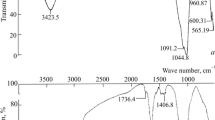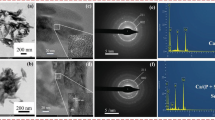Abstract
The incorporation of silicon can improve the bioactivity of hydroxyapatite (HA). Silicon-substituted HA (Ca10(PO4)6−x (SiO4) x (OH)2−x , Si-HA) composite coatings on a bioactive titanium substrate were prepared by using a vacuum-plasma spraying method. The surface structure was characterized by using XRD, SEM, XRF, EDS and FTIR. The bond strength of the coating was investigated and XRD patterns showed that Ti/Si-HA coatings were similar to patterns seen for HA. The only different XRD pattern was a slight trend toward a smaller angle direction with an increase in the molar ratio of silicon. FTIR spectra showed that the most notable effect of silicon substitution was that –OH group decreased as the silicon content increased. XRD and EDS elemental analysis indicated that the content of silicon in the coating was consistent with the silicon-substituted hydroxyapatite used in spraying. A bioactive TiO2 coating was formed on an etched surface of Ti, and the etching might improve the bond strength of the coatings. The interaction of the Ti/Si-HA coating with human serum albumin (HSA) was much greater than that of the Ti/HA coating. This might suggest that the incorporation of silicon in HA can lead to significant improvements in the bioactive performance of HA.








Similar content being viewed by others
References
Suchanek W, Yoshimura M. Processing and properties of hydroxyapatite-based biomaterials for use as hard tissue replacement implants. J Mater Res. 1998;13:94–117.
Sfidhar TM, Mudala UK, Subbaiyan M. Preparation and characterization of electrophoretically deposited hydroxyapatite coating on type 316L stainless steel. Corr Sci. 2003;45:237–52. doi:10.1016/S0010-938X(02)00091-4.
Zhitomirsky I, Galor L. Electrophoretic deposition of hydroxyapatite. J Mater Med. 1997;8:213–9.
Balas F, Perez PJ, Vallet RM. In vitro bioactivity of silicon-substituted hydroxyapatites. Biomaterials. 2003;24:3203–9.
Tang XL, Xiao XF, Liu RF. Structural characterization of silicon-substituted hydroxyapatite synthesized by a hydrothermal method. Mater Lett. 2005;59:3841–6. doi:10.1016/j.matlet.2005.06.060.
Thian ES, Huang J, Best SM, Barber ZH. Silicon-substituted hydroxyapatite: the next generation of bioactive coatings. Mater Sci Eng C. 2007;27:251–6. doi:10.1016/j.msec.2006.05.016.
Suzuki K, Yumura T, Mizuguchi M, et al. Apatite-silica gel composite materials prepared by a new alternate soaking process. J Sol–Gel Sci Technol. 2001;21:55–63.
Mondragon CZ, Vargas GG. Electrophoretic deposition of hydroxyapatite submicron particles at high voltages. Mater Lett. 2004;58:1336–9. doi:10.1016/j.matlet.2003.09.024.
Junichi HA, Yuki A, Kiyoshi K. Fabrication of highly ordered macroporous apatite coating onto titanium by electrophoretic deposition method. Solid State Ion. 2004;172:331–4. doi:10.1016/j.ssi.2004.02.046.
Wei M, Ruys AJ, Swain MV. Interfacial bond strength of electrophoretically deposited hydroxyapatite coatings on metals. J Mater Sci: Mater Med. 1999;10:401–9. doi:10.1023/A:1008923029945.
Niwa M, Wei L, Sato I. The adsorptive property of hydroxyapatite to albumin dextrin and lipids. Biomed Mater Eng. 1999;9:163–9.
Tanizawa Y, Suzuki T. X-ray photoelectron spectroscopy study of silicate-containing apatite. Phosphorus Res Bull. 1994;4:83–8.
Gibson IR, Best SM, Bonfield W. Chemical characterization of silicon-substituted hydroxyapatite. J Biomed Mater Res. 1999;4:422–8. doi:10.1002/(SICI)1097-4636(19990315)44:4<422::AID-JBM8>3.0.CO;2-#.
Le Ventouri TH, Bunaciu CE, Perdikatsis V. Neutron powder difraction studies of silicon-substituted hydroxyapatite. Biomaterials. 2003;24:4205–421. doi:10.1016/S0142-9612(03)00333-8.
Tao W-s, Li W, Jiang Y-M. The basic of protein molecules. 2nd ed. Beijing: Higher Education Press; 1995.
Yin G, Zhan J, Liu Z. Characterization of the adsorption of human serum albumin on hydroxylapatite. Chem J Chin Univ. 2002;22:771–5. J.
Author information
Authors and Affiliations
Corresponding author
Rights and permissions
About this article
Cite this article
Xiao, Fj., Peng, L., Zhang, Y. et al. Silicon-substituted hydroxyapatite composite coating by using vacuum-plasma spraying and its interaction with human serum albumin. J Mater Sci: Mater Med 20, 1653–1658 (2009). https://doi.org/10.1007/s10856-009-3723-3
Received:
Accepted:
Published:
Issue Date:
DOI: https://doi.org/10.1007/s10856-009-3723-3




